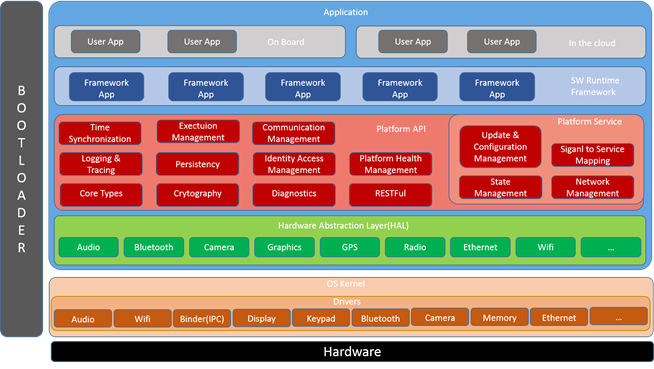- 知从木牛基础软件OBD
- 知从木牛基础软件英飞凌TC264
- 知从木牛OSEK网络管理恩智浦S32K344
- 知从木牛操作系统OS
- 知从木牛操作系统OS SC4
- TRICORE平台移植到ARM平台指导手册
- 知从木牛操作系统OS ARM CORTEX R52+
- 知从木牛基础软件英飞凌TC4X
- 知从木牛基础软件恩智浦S32K3
- 知从木牛基础软件英飞凌TLE989X
- 知从木牛AFE德州仪器BQ756506
- 知从木牛基础软件瑞萨RH850U2AX
- 知从木牛AUTOSAR软件平台英飞凌TC264
- 知从木牛基础软件杰发AC781X
- 知从木牛操作系统OS NG HYPERVISOR
- 知从木牛基础软件杰发AC7840
- 知从木牛基础软件瑞萨RH850F1KM
- 英飞凌TC3XX_Cache和Overlay功能详解
- 知从木牛基础软件芯旺微KF32A产品手册
- 知从木牛基础软件恩智浦S32K344产品
- 知从木牛基础软件紫光同芯THA6206
- 知从木牛基础软件平台
- 知从木牛AUTOSAR软件平台恩智浦S32K
- 知从木牛AUTOSAR软件平台恩智浦MPC5744P
- 知从木牛AUTOSAR软件平台英飞凌TC275
- 知从木牛SOC产品
随着时代的进步,智能化、网连化变成了当前汽车发展的大趋势。Classic AutoSAR是基于强实时性的嵌入式OS上开发出来的软件架构,能满足传统汽车定制化的功能需求,且能很好胜任;但是一旦要汽车接入网络,网络很可能有延迟、干扰,很可能无法满足强实时性。这种情况下Classic AutoSAR就无能为力了。
Adaptive Autosar与Classic Autosar相比,虽实时性要求有所降低,但在保证一定功能安全等级的基础上,大大提高了对高性能处理能力的支持,以支持智能互联应用功能的开发,因此C++将成为Adaptive Autosar平台的主要开发语言。
微处理器上执行的软件组件通常不是基于AUTOSAR Classic标准,取而代之的是AUTOSAR Adaptive,以满足模块化、动态性和持续更新能力的需求。AUTOSAR Adaptive正在成为汽车高性能平台上约定俗成的软件标准。AUTOSAR Adaptive使用符合POSIX标准的操作系统,如Linux、 PikeOS或QNX,并为其在汽车领域的应用提供了功能扩展。AUTOSAR Adaptive还为诊断、信息安全和功能安全提供功能支持。
在AUTOSAR Adaptive项目中,软硬件隔离使得OEM和供应商之间的任务分配有了新的变化。从前一个功能块通常被作为汽车中的一个物理设备来订购,现在完全可以做到只采购软件。为了实现这种方式,每个AUTOSAR Adaptive应用都是一个独立的二进制文件,应用开发将独立于ECU开发。
随着无人驾驶技术的如火如荼,车联网及万物互连、云技术的日益发展,Adaptive Autosar的出现不仅可满足现有需求,还可满足未来汽车技术的革新变化,由于其支持各种自适应的部署、复杂的微控制器以及各种非Auosar系统的互动,未来汽车将拥有不同类型的架构并互相进行补充。
知从木牛SOC产品是符合Adaptive AUTOSAR的ECU开发解决方案。该方案采用SOA架构设计,包括从系统功能设计,ECU功能映射和组件配置,运行时环境自动代码生成等一系列的工具套件,提供了一套经过实践验证的,开发可重用ECU应用软件的基础。
技术优势
Ø 支持SOME/IP协议,包括ECE保护;
Ø 支持DoIP协议,可以使用UDSOnIP进行OTA升级;
Ø 使用TLS和SecOC增加安全性;
Ø 内部通信使用IPC机制,以获得更好的性能和简化的配置;
Ø 实时检查TCP连接,确保服务稳定性;
Ø UDP帧缓冲机制减少网络过载;
Ø IP报文中进行优先级分配,保障高优先级应用的实时性;
Ø 可选静态服务发现机制,加速启动;
Ø 支持XCP测量和标定;
Ø 支持AutoIP机制;
知从木牛SOC产品基于SOA软件架构设计,兼容Adaptive AutoSAR的车辆解决方案。知从木牛SOC将经过量产验证的软件、开源软件以及第三方软件汇集一身,同时也融入对于HPC环境至关重要但并不区分不同汽车的工具和服务。知从木牛SOC集成了基于Linux和Adaptive AUTOSAR的高性能功能安全软件栈、一个基于Classic AUTOSA的实时安全软件栈、一个hypervisor ,以及用于HPC更新和平台健康管理功能的软件。另外还包括用于自动化构建和集成的工具和服务。
知从木牛SOC产品,支持SOA框架的服务开发。目前主要应用于如下场景:
Ø 高性能ECU,如ADAS,多媒体和联网应用
Ø 高度自动化操作相关的安全相关的系统
Ø Adaptive AUTOSAR相关的C++开发
Ø 车辆相关的独立软件开发
Ø SOA相关的服务开发
Ø SOC快速安全启动方案

知从木牛SOC将整个系统分成如下几个部分:
◆ Hardware:硬件层,涉及到具体的芯片开发板;
◆ BOOTLOADER:引导层,负责引导OS系统;
◆ OS Kernel: 操作系统内核层,驱动各种外部设备,如Audio,Bluetooth,Wifi等,OS Kernel除了驱动外设外,还负责其他多进程调用,内存管理,磁盘管理等其他OS常规功能;
◆ Application:应用层负责具体的功能实现,至下而上分别实现了HAL,Platform API, SW Runtime FrameWork和User App:
◆ HAL:虚拟层,负责将底层设备抽象,变成标准API供上层应用调用;
◆ Platform API:Platform API实现了Adaptive 平台基础组件,包括十一个API和四个常用服务:
Ø Time Synchronzation:时间同步,负责系统时钟与外部时钟的同步;
Ø Execution Mangement:执行管理,负责程序的执行以及解决程序的相互依赖;
Ø Communication Management:负责通信管理,包括外部通信和内部通信管理;
Ø Logging &Tracing:日志和跟踪,分析系统风险;
Ø Persitency:访问非易失性存储器的接口;
Ø Identity Acess Management:身份和访问管理,进行风险管理;
Ø Platform Health Management:平台健康管理,系统负载,状态等管理;
Ø Core Types: 系统通用类和功能,如错误处理和复杂数据类型;
Ø Cryptography:通用加密操作和安全密钥管理的接口;
Ø Diagnostics :诊断相关服务管理;
Ø RESTFul:负责构建RESTful以及特定服务;
四个常用服务:
Ø Update &Configuration Management:处理软件更新请求的服务;
Ø State Management:状态管理,负责平台运行状态的所有方面,包括处理传入事件,确定这些事件/请求的优先级以设置相应的内部状态。
Ø Signal To Service Mapping:信号对服务的映射;
Ø Network Management:网络管理服务,协调内部协调状态机中基础网络的正常运行和总线睡眠模式之间的转换;
◆ SW Runtime Framework:软件运行框架,一般指系统级程序运行环境;
◆ User App:用户自定义应用程序,可以在本地运行,也可以远程运行,通过API接口与系统交互;

点击下载产品手册